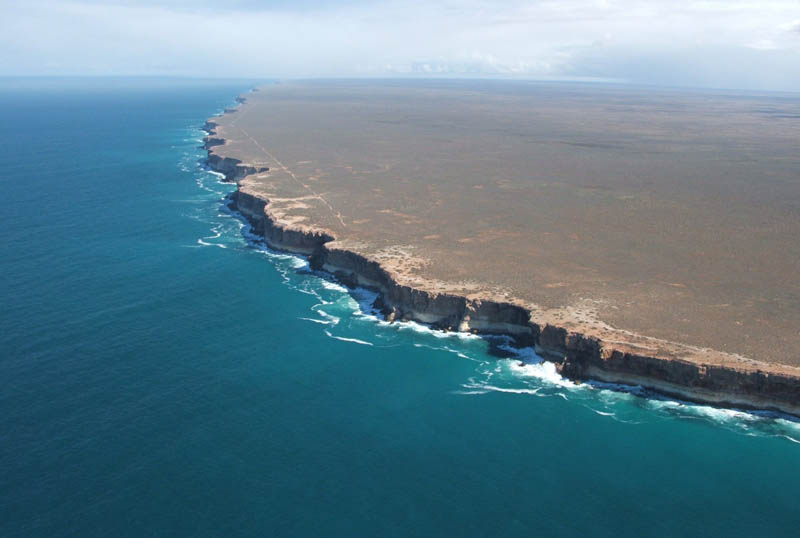
The vast Nullarbor Plain is the world’s largest limestone karst landscape covering an area of 270,000 square km, extending 2,000 km between Norseman and Ceduna. Two thirds of the Nullarbor is within Western Australia and one third is in South Australia.
The spectacular Bunda Cliffs and the Great Australian Bight border the area to the south and the northern border is the Great Victoria Desert.
The name Nullarbor derives from “no trees”, but the plain is covered with bluebush and saltbush plants, hardy shrubs that are drought-resistant and salt-tolerant. The outer edges of the Nullarbor house open woodlands of Myall acacias.
The 1984 Biological Survey of the Nullarbor identified:
– 794 vascular plant species
– 56 mammals – with one of Australia’s largest populations of southern hairy-nosed wombats
– 249 bird species – including the endemic Nullarbor Quail and Nareth Blue Bonnet
– 86 reptile species and 1 frog – Within the study areas a large number of new records and range extensions were recorded
The Nullarbor Plain – world’s largest limestone karst landscape
- Bunda Cliffs, Nullarbor, South Australia
The vast Nullarbor Plain is the world’s largest limestone karst landscape covering an area of 270,000 square km, extending 2000 km between Norseman and Ceduna. Two thirds of the Nullarbor is within Western Australia and one third is in South Australia.
The spectacular Bunda Cliffs and the Great Australian Bight border the area to the south and the northern border is the Great Victoria Desert.
The value of this landscape is recognised internationally as an important natural and cultural resource. Greater protection for this fragile landscape is essential through the development and implementation of conservation strategies using the Wildcountry vision. No management plan currently exists to protect the Nullarbor’s fragile landscape.
Nullarbor environment
The name Nullarbor derives from “no trees”, but the plain is covered with bluebush and saltbush plants, hardy shrubs that are drought-resistant and salt-tolerant. The outer edges of the Nullarbor house open woodlands of Myall acacias.
The 1984 Biological Survey of the Nullarbor identified:
- 794 vascular plant species
- 56 mammals – with one of Australia’s largest populations of southern hairy-nosed wombats
- 249 bird species – including the endemic Nullarbor Quail and Nareth Blue Bonnet
- 86 reptile species and 1 frog – Within the study areas a large number of new records and range extensions were recorded.
Karst features
- Caigana Blowhole, Nullarbor, South Australia.
Over time crystal weathering erodes the fragile limestone plain producing special landscape features. Dolines, or large circular depressions, are found through out the Karst surface. Over 250 caves are recorded, in some caves the ocean flows up to several hundreds of metres from the coastline forming underground river systems and creating blow holes like Murrawjinie Cave.
The caves provide habitat for unusual and endemic fauna and are very important cultural heritage for the indigenous Mirning people. Rock holes are another karst feature, which are important for conservation and cultural heritage. They are the only place that surface water can collect within the dry plain.
Land Uses
The dominant land uses of the Nullarbor are wildlife conservation, indigenous people’s hunting and cultural practices, adventure tourism, mineral exploration and pastoralism.
The Nullarbor National Park (declared in 1979) and Regional Reserve (proclaimed in 1989) cover 2,873,000 hectares to ‘protect’ the worlds largest semi-arid cave karst system. These park classifications were put in place to provide a framework to protect a significant area of natural habitat while allowing use of the natural resources.
However no management plan has been established for the reserve, partly due to lack of resources where a couple of local Department of Environment staff have to manage an area the size of Tasmania.
Across the border, the Eucla National Park in the south-east corner of WA is the 3,340ha. The Park’s most significant features are the vast Delisser Sandhills and Wilson Bluff, a high limestone cliff which provides inspiring views of the coastal cliffs stetching from Eucla for hundreds of kilometres to the east. The Park’s flora is mallee scrub and heathland. Whales, seals and albatrosses can been seen from the ocean front.
The multiple use Nuytsland Nature Reserve a 625,344ha reserve declared in 1969 extends almost five hundred kilometers along the coast, from Red Rocks Point in the east to Cape Pasley in the west of Western Australia.
Twilight Cove within the nature reserve is a significant cultural feature along the Nullarbor with a view of the 70 metre limestone cliffs which overlook the Great Australian Bight. Access to the Cove is by four wheel drive vehicles only.
Causes for concern
- Cocklebiddy Cave, Nullarbor, South Australia.
The level of visitor impacts have not been documented, but increasing tourism in the Nullarbor is resulting in damage. The Nullarbor continues to suffer with unrestricted access, because there is little on ground management. Dolines and caves are being affected the most.
Feral and introduced animals such as cats, camels, foxes and, especially rabbits are also problematic. Rabbits eat young seedlings, are causing a decline in certain shrubs, which in turn affects resident bird species.
Conservation strategies
A WildCountry vision of landscape scale conservation is necessary to protect this vast area, as is the recognition and incorporation of the vision and knowledge of Australia’s indigenous people. The WildCountry vision supports indigenous custodians being incorporated into, and managing, conservation strategies.
The far west Aboriginal groups’ interests form an important part of the mosaic of protected areas and conservation agreements that need to be established to achieve high-level protection of the diverse and magnificent environments of Nullarbor plain. Long term resources should be made available to manage the natural and cultural values of the land, and sustain the livelihood of the families and communities that reside there.
For more information, please contact:
The Wilderness Society (South Australia) Inc
Postal: GPO Box 1734
Adelaide, SA, 5001
Lvl 7, 118 King William St,
Adelaide, SA, 5000
Phone: 08 8231 6586







